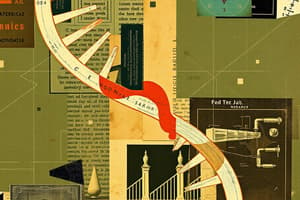Podcast
Questions and Answers
What characterizes a double auction?
What characterizes a double auction?
- A type of auction that only allows sealed bids.
- A single buyer negotiates directly with a single seller.
- Multiple buyers and sellers interact with matched bidding and asking prices. (correct)
- An auction where prices are fixed and cannot be altered by participants.
In a double auction, what is taken into consideration?
In a double auction, what is taken into consideration?
- Bidders are limited to a fixed asking price set by sellers.
- The quantities of goods on both the buyer and seller's sides. (correct)
- Only the sellers’ asking prices without regard for bidders.
- Only the highest bidder wins, regardless of seller's asking prices.
How does a double auction differ from a traditional auction?
How does a double auction differ from a traditional auction?
- A double auction allows for an unlimited number of bids.
- In double auctions, the price fluctuations do not occur.
- It involves multiple buyers and sellers rather than just a single interaction. (correct)
- A double auction includes only one seller.
What is a common misconception about double auctions?
What is a common misconception about double auctions?
Which of the following best defines a double auction?
Which of the following best defines a double auction?
What is a blog primarily defined as?
What is a blog primarily defined as?
Which of the following best describes the interaction allowed on a blog?
Which of the following best describes the interaction allowed on a blog?
What is the primary focus of a blog?
What is the primary focus of a blog?
Which characteristic distinguishes a blog from traditional websites?
Which characteristic distinguishes a blog from traditional websites?
Which of the following statements about blogs is false?
Which of the following statements about blogs is false?
What is the primary function of shopping portals?
What is the primary function of shopping portals?
What is an e-mall?
What is an e-mall?
Which type of shopping portal caters to specialized markets?
Which type of shopping portal caters to specialized markets?
Which of the following best describes the purpose of electronic malls?
Which of the following best describes the purpose of electronic malls?
How can shopping portals benefit online shoppers?
How can shopping portals benefit online shoppers?
What characteristic distinguishes comprehensive shopping portals from niche ones?
What characteristic distinguishes comprehensive shopping portals from niche ones?
What distinguishes an e-mall from other online retail platforms?
What distinguishes an e-mall from other online retail platforms?
Which of the following is NOT a type of shopping portal?
Which of the following is NOT a type of shopping portal?
Why are e-malls becoming an important part of online shopping?
Why are e-malls becoming an important part of online shopping?
Which of the following is NOT a characteristic of e-malls?
Which of the following is NOT a characteristic of e-malls?
What is the primary role of an e-distributor in e-commerce?
What is the primary role of an e-distributor in e-commerce?
How does an e-distributor typically present product offerings to users?
How does an e-distributor typically present product offerings to users?
Which of the following is NOT a characteristic of an e-distributor?
Which of the following is NOT a characteristic of an e-distributor?
What advantage does an e-distributor provide to manufacturers?
What advantage does an e-distributor provide to manufacturers?
In an e-distributor model, who primarily benefits from the aggregation of catalogs?
In an e-distributor model, who primarily benefits from the aggregation of catalogs?
What year was the copyright for the content established?
What year was the copyright for the content established?
Which of the following companies is mentioned as the publisher?
Which of the following companies is mentioned as the publisher?
In which format is the content published?
In which format is the content published?
What is the significance of the phrase 'Copyright © 2011 Pearson Education, Inc.'?
What is the significance of the phrase 'Copyright © 2011 Pearson Education, Inc.'?
What does 'Prentice Hall' refer to in this context?
What does 'Prentice Hall' refer to in this context?
Flashcards
e-mall
e-mall
An online shopping center with many online stores.
Online Shopping Center
Online Shopping Center
A place where online stores gather to sell their items.
Online Stores
Online Stores
Shops that sell their products through the internet.
Electronic Mall
Electronic Mall
Signup and view all the flashcards
Retailers
Retailers
Signup and view all the flashcards
E-distributor
E-distributor
Signup and view all the flashcards
Manufacturers
Manufacturers
Signup and view all the flashcards
Business buyers
Business buyers
Signup and view all the flashcards
Aggregating catalogs
Aggregating catalogs
Signup and view all the flashcards
Intermediary
Intermediary
Signup and view all the flashcards
Double Auction
Double Auction
Signup and view all the flashcards
Online Auction
Online Auction
Signup and view all the flashcards
Shopping Portals
Shopping Portals
Signup and view all the flashcards
E-storefronts
E-storefronts
Signup and view all the flashcards
Niche-oriented
Niche-oriented
Signup and view all the flashcards
Comprehensive Shopping Portals
Comprehensive Shopping Portals
Signup and view all the flashcards
Blog
Blog
Signup and view all the flashcards
Weblogging
Weblogging
Signup and view all the flashcards
What is the purpose of a blog?
What is the purpose of a blog?
Signup and view all the flashcards
What can a blog be used for?
What can a blog be used for?
Signup and view all the flashcards
How do people interact with blogs?
How do people interact with blogs?
Signup and view all the flashcards
Online Retailer
Online Retailer
Signup and view all the flashcards
Study Notes
Chapter 2: E-Marketplaces: Mechanisms, Tools, and Impacts of E-Commerce
- Learning Objectives:
- Describe major e-commerce activities and processes, and supporting mechanisms.
- Define e-marketplaces and list their components.
- List major e-marketplace types and describe their features.
- Describe electronic catalogs, search engines, and shopping carts.
- Describe major auction types and their characteristics.
- Discuss auction benefits, limitations, and impacts.
- Describe online bartering and negotiation.
- List major Web 2.0 tools and their use in e-commerce.
- Understand virtual worlds and their use in e-commerce.
Exhibit 2.1: EC Activities-Mechanism Connection
- Shows relationships between e-commerce activities and mechanisms.
- Activities include presence & discovery, trading, communication, & learning, entertainment & improvement, and other activities.
- Mechanisms include electronic markets, storefronts, malls, portals, E-catalogs, search engines, shopping carts, directories, E-maps, E-auctions, Web 2.0 tools, social network services, virtual worlds, payment, order processing, security & support.
Exhibit 2.2: EC Activities
- Illustrates the connection between suppliers, the seller (company), and customers (individuals, businesses, or government).
- Types of transactions include B2B (business-to-business), intra-business transactions, and B2B, B2C, B2G (business-to-business, business-to-consumer, business-to-government) transactions.
E-marketplaces
- An online marketplace, typically B2B, where buyers and sellers exchange goods or services.
- Types: private, public, and consortia.
Exhibit 2.3: Buying Process in an E-Market
- Shows a flow chart of the buying process in an e-market.
- Stages include pre-shopping activities, entering the e-shop, registering, comparing, finding the catalog, buying/not buying, shopping cart, checkout, shipment, payment, viewing order, returning items, and post-shopping activities.
Exhibit 2.4: Functions of a Market
- Categorizes the functions in a market (facilitation of transactions and institutional infrastructure):
- Matching of Buyers and Sellers: product offerings, search for buyers and sellers, price discovery, organizing bids
- Facilitation of Transactions: logistics, settlement, trust
- Institutional Infrastructure: legal (e.g., commercial code), regulatory, discovery
Marketspace
- A marketplace (online) for the exchange of goods and services for money.
E-marketplace Components and Participants
- Components: customers, sellers (and their products/services), infrastructure
- Products/services include digital products (goods delivered via internet).
- Infrastructure includes the physical or virtual foundations supporting the marketplace.
E-marketplace Components and Participants (Front-end/Back-end/Intermediary)
- Front-end: portion of e-seller's business accessed by customers (seller's portal, catalogs, shopping cart, search engine, payment gateway).
- Back-end: activities supporting fulfillment, inventory, purchasing from suppliers, processing payments, packaging & delivery.
- Intermediary: third party between sellers and buyers.
Disintermediation
- Elimination of intermediaries between buyers and sellers.
Types of E-Marketplaces
- Private E-Marketplaces:
- Sell-side: one company selling products to qualified companies (e.g., standard and/or customized).
- Buy-side: one company purchasing from invited suppliers.
- Public E-Marketplaces
Customer Interaction Mechanisms: Storefronts, Malls, and Portals
- Webstore (storefront): an individual company's website with product sales and shopping cart functions.
- E-mall (online mall): an online shopping center with multiple stores.
- Web (information) portal: a single point of access to business information inside and outside an organization. Types include: Commercial, Corporate, Publishing, Personal, mobile, voice, and knowledge portals.
Roles and Value of Intermediaries in E-Marketplaces
- Brokers: buy/sell fulfillment, virtual mall, metamediary, comparison agent, shopping facilitator, matching services.
Customer Interaction Mechanisms: Infomediaries / E-distributor
- Infomediaries: e-intermediaries controlling information flow, often aggregating and reselling it.
- E-distributor: E-commerce intermediaries connecting manufacturers with business buyers (customers) by aggregating catalogs.
Electronic Catalogs, Search Engines, and Shopping Carts
- Electronic catalogs (e-catalogs): electronic product information presentations.
- Advantages of online catalogs over paper catalogs: Easy updating, integrating with the purchasing process, good search capabilities, providing timely product information, ease of customization.
- Disadvantages: difficult to develop, large fixed costs, need for customer computer/browser skills.
- EC Search Activities, Types, and Engines:
- Internet/Web Search
- Enterprise Search: identifying and enabling specific content across the enterprise for authorized users.
- Desktop search: searches a computer's contents (as opposed to the internet).
- Search engine: a computer program accessing Internet databases for keywords/information, reporting results.
- Software (Intelligent) Agents
- Voice-Powered Search
- Electronic Shopping Cart: an order processing technology to let customers accumulate items and continue shopping.
Auctions, Bartering, and Negotiating Online
- Auction: a competitive process for bids, prices dynamically determined by bids (forward and backward auctions).
- Types of Auctions:
- One Buyer, One Seller
- One Seller, Many Potential Buyers (forward auction): a seller receives bids sequentially.
- One Buyer, Many Potential Sellers (reverse auction): a buyer receives bids sequentially.
- Name-your-own-price model: buyer specifies price, a C2B model.
- Double auction: multiple buyers and their bids are matched with multiple sellers and their asking prices.
Auctions, Bartering and Negotiating Online Continued
- Limitations of E-Auctions: Minimal security, possibility of fraud, limited participation.
- Impacts of Auctions: auctions as a social mechanism, visible distribution method, EC component in business models, Profit for individuals.
Web 2.0 Tools and Services: From Blogs to Wikis to Twitter
- Blogging (Weblogging): a personal website accessible to the public, discussing specific topics.
- Vlog (video blog): a blog with video content.
Chapter 3: Retailing in Electronic Commerce: Products and Services
- Learning Objectives:
- Describe electronic retailing (e-tailing) and its characteristics.
- Define and describe primary e-tailing business models.
- Describe online travel and tourism services, their impact, participants, benefits, and limitations.
- Describe online real estate services.
- Discuss online stock trading services.
- Discuss cyberbanking and online personal finance.
- Describe on-demand delivery services.
- Describe delivery of digital products and online entertainment.
- Discuss online consumer aids (comparison shopping).
- Describe disintermediation and other B2C strategic issues.
- E-tailing and Internet Marketing: The size and growth of the B2C market.
- What sells well on the internet (items by category).
- Travel, Computer Hardware and Software, Consumer Electronics, Office Supplies, Sport and Fitness Goods, Books and Music, Toys, Health and Beauty, etc.
Internet Marketing and Electronic Retailing (continued)
- Considered commerce: Online channel integrated with a physical retail business.
Characteristics and Advantages of Successful E-tailing
- Sound business thinking, visionary leadership, and well-thought-out strategies are important for success.
- Implementing stable and scalable technology infrastructure is vital, including support for both online and physical business operations.
E-tailing Business Models (Classification by Distribution Channel)
- Direct marketing by mail-order retailers that go online.
- Direct sales by manufacturers.
- Pure-play e-tailers.
- Click-and-mortar retailers.
- Internet (online) malls.
Travel and Tourism (Hospitality) Services Online
- Services Provided:
- Wireless services.
- Direct marketing.
- Alliances and consortia.
- Travel-Oriented Social Networks.
Travel and Tourism Services (continued)
- Benefits: Free information, anytime/anywhere access, substantial discounts.
- Limitations: Many people don't use the internet, difficulty with complex trips require stopovers.
Employment Placement and the Job Market
- Job seekers and employers both use the internet job market.
- Online markets on social networks exist
- Global online portals
Real Estate, Insurance, and Stock Trading Online
- Real estate online:
- Zillow.
- Insurance online: (specific details not provided)
- Online stock trading:
- Commission ($1-19).
- Major risk = security
Banking and Personal Finance Online
- E-banking: various banking activities from home or the road using the internet
- Consumer use: checking accounts, paying bills, securing loans
Banking and Personal Finance Online (continued)
- Home banking capabilities (informational/administrative/transactional)
- Virtual Banks: banks that exist only online (e.g., PayPal).
Online Financial Transaction Implementation Issues
- Securing financial transactions, image systems (which make images of every transaction), fees (for online versus offline services)
- Online billing and bill-paying (growing use)
On-Demand Delivery of Products, Digital Items, Entertainment, and Gaming
- E-grocer: online orders with delivery schedules or within a short period.
- On-demand delivery service: express delivery.
Online Purchase-Decision Aids
- Shopping portals: gateways to e-storefronts and e-malls (comprehensive or niche oriented)
- Shopping robots (agents/shopbots): tools scouting the web based on criteria
- "Spy" services
- Wireless shopping comparisons
- Business ratings sites: for assessing/verifying companies,
- Trust verification sites
- Referral economy: effect of referrals on sales
Issues in E-tailing and Lessons Learned
- Channel conflict.
- Determining the right price.
- Product and service customization.
- Fraud and other illegal activities
- Lessons learned from failures.
- Speak with one voice
- Leverage multi-channels
- Empower the customer
Chapter 6: Innovative Systems: From E-Government and E-Learning to C2C E-Commerce and Collaborative Commerce
- Learning Objectives:
- Describe various e-government initiatives.
- Understand e-government implementation issues (e.g., e-government 2.0, m-government).
- Describe e-learning, virtual universities, and e-training.
- Describe e-books.
- Describe knowledge management and dissemination.
- Describe C2C activities.
- Describe collaborative commerce.
E-government (An Overview)
- E-commerce model for a government entity that buys from or provides goods, services, or information to businesses or citizens.
- Government-to-Citizen (G2C): Electronic voting, Electronic Benefits Transfer.
- Government-to-Business (G2B): Government E-Procurement, Group Purchasing, Forward E-Auctions.
- Other types: Government-to-Government (G2G), and Government-to-Employees (G2E).
- Internal Efficiency and Effectiveness (IEE) : initiatives for improving efficiency of government operations (e.g., E-payroll, E-records management).
E-learning
- Online delivery for education, training, and knowledge management.
- Benefits: time reduction, large volume/diversity, cost reduction, higher content retention, flexibility, updated material, and a fear-free environment.
- Drawbacks: instructor retraining, equipment needs and support, lack of face-to-face interaction, assessment, maintenance/updating, protection of intellectual property, computer literacy, and student retention. Distance learning, and Virtual University
E-books
- Digital book formats, read on computer screens or special devices
- Devices for reading e-books (e.g., Kindle, Sony PRS-200, Nook)
- Advantages and limitations
- Devices for reading e-books (e.g., Kindle, Sony PRS-200, Nook)
Knowledge Management (KM)
- KM: process of capturing, creating, storing, updating, disseminating, and using knowledge whenever needed.
- KM Types and Activities: create, capture, refine, store, manage, disseminate, knowledge sharing, knowledge application. Online advising and consulting, expert location systems
Collaborative Commerce (c-commerce)
- Using digital technologies for collaboratively managing, planning, developing, and researching products, services, and innovative EC applications.
- Collaboration Hub
- Barriers to c-commerce: technical factors, security/privacy concerns, partner database access, internal resistance to information sharing, lack of internal skills.
Studying That Suits You
Use AI to generate personalized quizzes and flashcards to suit your learning preferences.




